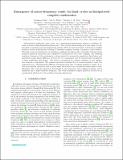Files in this item
Emergence of microfrequency comb via limit cycles in dissipatively coupled condensates
Item metadata
| dc.contributor.author | Kim, Seonghoon | |
| dc.contributor.author | Rubo, Yuri G. | |
| dc.contributor.author | Liew, Timothy C. H. | |
| dc.contributor.author | Brodbeck, Sebastian | |
| dc.contributor.author | Schneider, Christian | |
| dc.contributor.author | Höfling, Sven | |
| dc.contributor.author | Deng, Hui | |
| dc.date.accessioned | 2020-02-06T11:30:06Z | |
| dc.date.available | 2020-02-06T11:30:06Z | |
| dc.date.issued | 2020-02-18 | |
| dc.identifier | 266242387 | |
| dc.identifier | 4e9e0d04-1ba5-4b16-a666-8cf157842cfc | |
| dc.identifier | 85079739925 | |
| dc.identifier | 000514175800009 | |
| dc.identifier.citation | Kim , S , Rubo , Y G , Liew , T C H , Brodbeck , S , Schneider , C , Höfling , S & Deng , H 2020 , ' Emergence of microfrequency comb via limit cycles in dissipatively coupled condensates ' , Physical Review. B, Condensed matter and materials physics , vol. 101 , no. 8 , 085302 . https://doi.org/10.1103/PhysRevB.101.085302 | en |
| dc.identifier.issn | 1098-0121 | |
| dc.identifier.other | ArXiv: http://arxiv.org/abs/1809.04641v2 | |
| dc.identifier.uri | https://hdl.handle.net/10023/19418 | |
| dc.description.abstract | Self-sustained oscillations, limit cycles, are a fundamental phenomenon unique to nonlinear dynamic systems of high-dimensional phase space. They enable understanding of a wide range of cyclic processes in natural, social and engineering systems. Here we show that limit cycles form in coupled polariton cavities following the breaking of Josephson coupling, leading to frequency-comb emission. The limit cycles and destruction of Josephson coupling both appear due to interplay between strong polariton-polariton interaction and a dissipative contribution to the cavity coupling. The resulting nonlinear dynamics of the condensates is characterized by asymmetric population distribution and nontrivial average phase difference between the two condensates, and by time-periodic modulation of their amplitudes and phases. The latter is manifested by coherent emission of new equidistant frequency components. The emission spectrum resembles that of a micro-frequency comb, but originates from a fundamentally different mechanism than that of existing frequency combs. It allows non-resonant excitation with a power input much below the conventional semiconductor laser threshold. The comb line spacing is determined by the interaction and coupling strengths, and is adjustable up to multi-terahertz frequency. The work establishes coupled polariton cavities as an experimental platform for rich nonlinear dynamic phenomena. | |
| dc.format.extent | 2677185 | |
| dc.language.iso | eng | |
| dc.relation.ispartof | Physical Review. B, Condensed matter and materials physics | en |
| dc.subject | QC Physics | en |
| dc.subject | TK Electrical engineering. Electronics Nuclear engineering | en |
| dc.subject | 3rd-DAS | en |
| dc.subject.lcc | QC | en |
| dc.subject.lcc | TK | en |
| dc.title | Emergence of microfrequency comb via limit cycles in dissipatively coupled condensates | en |
| dc.type | Journal article | en |
| dc.contributor.institution | University of St Andrews. School of Physics and Astronomy | en |
| dc.contributor.institution | University of St Andrews. Condensed Matter Physics | en |
| dc.identifier.doi | 10.1103/PhysRevB.101.085302 | |
| dc.description.status | Peer reviewed | en |
This item appears in the following Collection(s)
Items in the St Andrews Research Repository are protected by copyright, with all rights reserved, unless otherwise indicated.

